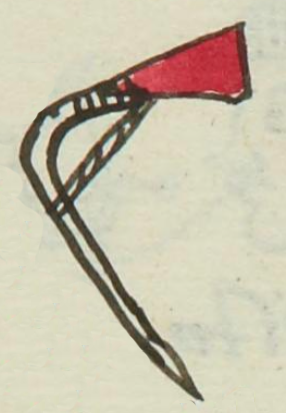Tlaxinqui (MH522r)
This simplex glyph for the personal name (or perhaps occupation) Tlaxinqui ("Carpenter," attested her as a man's name) shows an axe, suggesting the cutting of wood. This axe has a curved handle, a red triangular blade, and an added support (possibly a cord) across the curve of the handle. The head of the axe is on the viewer's right.
Stephanie Wood
The gloss for this name inadvertently omits the "n," but the noun comes from the verb xima, to cut or shave, which has the stem xin-. The red color for this axe may imply that it is made from copper. It is similar in shape and design to the tepoztli (copper axe)--see below. The texinqui axe may be meant for carving stone as opposed to cutting wood. For other examples of the glyph for the occupation tlaxinqui (not the name, as it seems to be here), see the Gran Diccionario Náhuatl, https://gdn.iib.unam.mx/diccionario/tlaxinqui/20874. This occupation is referenced several times in the Matrícula de Huexotzinco.
Stephanie Wood
thomas tlaxiqui
Tomás Tlaxinqui
Stephanie Wood
1560
José Aguayo-Barragán, Stephanie Wood
axes, hachas, tools, herramientas, nombres de hombres
Some of these examples of copper from Post-Classic Michoacan provide an idea of how axe heads or hatchet heads might have been made. Museo Nacional de Antropología e Historia, Sala 10. Photo by S. Wood, 30 April 2025.

tlaxinqui, carpenter, https://nahuatl.wired-humanities.org/content/tlaxinqui
xima, https://nahuatl.wired-humanities.org/content/xima
El Carpintero
José Aguayo-Barragán
Matrícula de Huexotzinco, folio 552r, World Digital Library. https://www.loc.gov/resource/gdcwdl.wdl_15282/?sp=183&st=image
This manuscript is hosted by the Library of Congress and the World Digital Library; used here with the Creative Commons, “Attribution-NonCommercial-ShareAlike 3.0 License” (CC-BY-NC-SAq 3.0).






